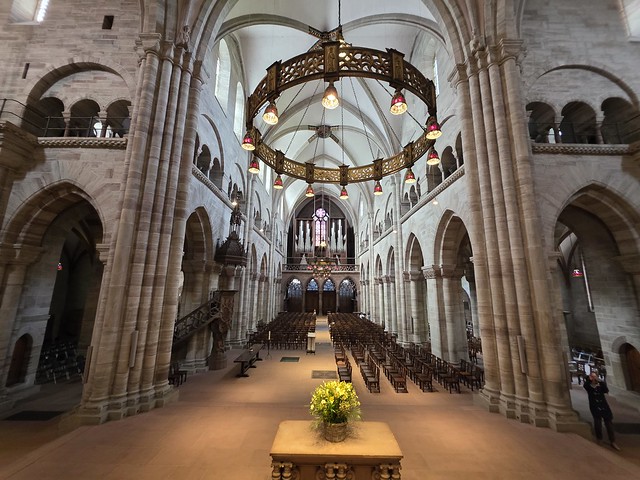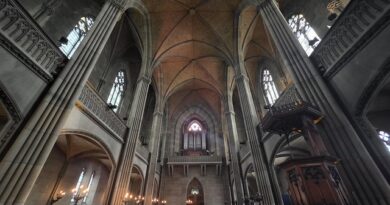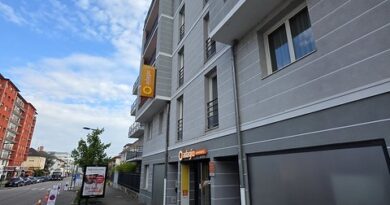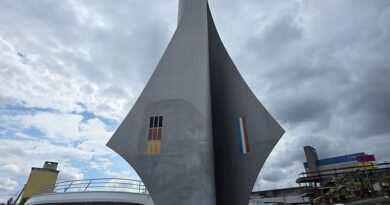Basel – Basel Minster
This is perhaps the major landmark in Basel, the medieval Minster, located on Münsterhügel (or Cathedral Hill). The first religious building on the site was probably constructed here in around the ninth century, but it was expanded and rebuilt a few times until and a grand new structure was completed in something like the 1220s. The cathedral sort of, well, fell down in the 1356 earthquake, but they built back better and stronger. The first phase of reconstruction finished in 1363 and by all accounts, it was once again a grand Minister.
In the fifteenth century, the rebuilt Minster became the backdrop for a major event in European church history, the Council of Basel. Convened initially by Pope Martin V in 1431 (who promptly died shortly thereafter), the Council aimed to address church reform (which seems rather aspirational to me) and resolve the Hussite Wars. Held within the Minster’s walls, the Council became a focal point for the Conciliar Movement, which asserted the authority of church councils over that of the Pope. This whole arrangement placed Basel and its Minster at the epicenter of ecclesiastical power struggles, attracting dignitaries and theologians from across Christendom in the debate between whether the Pope was all powerful or not. What happened, like after most things created to end disputes, was that there was a huge schism and decades of arguments.
But, there were huge changes to come, as the Reformation hit Basel with some force in 1529. The Minister found its statues smashed by the local populace following a surge in religious fervour, and realistically a load of alcohol, with altarpieces destroyed and substantial damage to the building and indeed other churches in the city. In many cities, the organ was smashed up as part of this revolution, but the populace quite liked the music that came out of Basel Minister, so they kept it. What it meant was that the Catholic church lost their Minster, but the Protestants gained one. The two towers are called Georgsturm and Martinsturm, the former dates to 1430 and is 67.3 metres high, whilst the latter was finished in 1500 and is 65.5 metres in height.
This bit of action on the front of the Minister is St. George slaying a dragon and the sculpture is thought to date to around 1450. Although, and not being critical, it looks like a baby dragon that isn’t very ferocious, but the Swiss have always been a peace loving nation and perhaps this is the most that they could muster.
The north aisle in the Minister.
The nave, with the post-earthquake Gothic ribbed vaults.
Some choir stalls which seemed to have some age to them.
The tomb of Thüring von Ramstein who died in 1307 and he was the Dompropst, or ‘Provost of the Cathedral Chapter’, a senior ecclesiastical official just below the Bishop.
The St. Vincent Panel (Vincentiustafel) located in the north aisle. The relief depicts the ‘Martyrdom of St. Vincent’ (Martyrium des HL. Vincenz) of Saragossa, a deacon who was martyred around 304 AD in Valencia in Spain, during the persecutions under the Roman Emperor Diocletian. This sculpture is important as it was created in around 1100 and was installed in the cathedral which partly fell down in the earthquake, so it’s one of the oldest artworks still in the building.
Looking towards the choir and apse, it’s a grand affair.
A stained glass rose window in the south transept with the stone tracery depicting the Star of David.
Looking back down the nave and the stone pulpit, dating to 1486 and designed by Hans von Nussdorf, is visible.
Looking up to the impressive mid-nineteenth century stained glass above the apse.
Stained glass dating from the nineteenth century,
Look into the crypt from above.
The font is carved from sandstone and dates from around the early sixteenth century. There’s a grander font in the crypt, which isn’t accessible at the moment, but this is the one now used for baptisms and it’s octagonal and highly decorated.
A side door on the West Facade and there used to be a statue of the Virgin Mary here, but that went during the Reformation. The reddish sandstone used on the exterior is mainly sourced from quarries in the nearby Wiesental and Degerfelden regions across the Rhine in what is now Germany.
It’s not a very clear image, but the roof has a rather lovely decorative pattern.
It’s certainly worth visiting and there’s no admission charge, although it was a shame that the crypt was shut for the winter months and slightly odd that there was no history anywhere about the building.




















